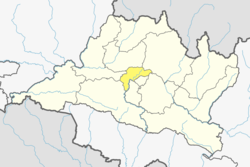Budhanilkantha
बूढानीलकण्ठ | |
|---|---|
Municipality | |
| Budhanilkantha Municipality | |
From top, left to right: Budhanilkantha skyline from Jhanda Park, Budhanilkantha School, Budhanilkantha Temple, Snow clad Shivapuri hills seen from the playground. | |
| Coordinates: 27°46′N 85°22′E / 27.767°N 85.367°E | |
| Country | |
| Zone | Bagmati |
| District | Kathmandu |
| Named after | Budhanilkantha Temple |
| Government | |
| • Mayor | Mitharam Adhikari (UML) |
| • Deputy Mayor | Anita Lama (UML) |
| Area | |
• Total | 34.8 km2 (13.4 sq mi) |
| Population | |
• Total | 179,688 |
| • Rank | 14th (Nepal) 5th (Bagmati Province) |
| • Density | 5,200/km2 (13,000/sq mi) |
| • Ethnicities | Bahun Chhetri Newar Tamang Magar |
| • Religions | Hindu Buddhist |
| Time zone | UTC+5:45 (NST) |
| Website | http://budhanilkanthamun.gov.np |
 | |
Budhanilkantha is a city and municipality in Kathmandu district of Bagmati province of Nepal. It is the 3rd largest city in the Kathmandu Valley after Kathmandu and Lalitpur. As per 2021 Nepal census, the city population was 179,688 and 26,678 households.[1]
It was established on 2 December 2014 by merging the former Village development committees Hattigauda, Khadka Bhadrakali, Chapali Bhadrakali, Mahankal, Bishnu, Chunikhel and Kapan.[2][3] The city is situated at the foot of Shivapuri hill. At the time of the 2011 Nepal census, the VDC of Budhanilkantha had a population of 15,421.[4]
The municipality is named after the sacred Budhanilkantha Temple. The Budhanilkantha School is also located within the municipality.
Toponymy
[edit]Linguistic origin
[edit]- Linguistic family: Indoeuropean
- Language: Sanskrit
Etymology
[edit]“Budha” means elderly person or, in a respectful sense, a way of referring to a deity. “Nilkantha” refers to Lord Shiva, the “blue-throated” god. The place is named after the large statue of Lord Nilkantha (Shiva) found there, combining “Budha” (deity) and “Nilkantha.”
Budha (बुढा) means “elder, old man” and comes from Nepali बुढा, which can also mean “venerable deity” in local usage; derived from Sanskrit वृद्ध (vṛddha) meaning “aged” or “respected elder". Nilkantha (नीलकण्ठ) means “blue throat” and comes from Sanskrit नील (nīla), meaning “blue” and कण्ठ (kaṇṭha) meaning “throat.” This is a well-known epithet of Shiva, referencing the myth where he drank poison during the churning of the ocean (samudra manthan). The toponym reflects both physical iconography (the statue) and religious reverence, combining local honorific usage with classical Sanskrit epithets.[5]
Gallery
[edit]

See also
[edit]References
[edit]- ^ "Archived copy" (PDF). cbs.gov.np. Archived from the original (PDF) on 6 February 2022. Retrieved 22 February 2022.
{{cite web}}: CS1 maint: archived copy as title (link) - ^ "Govt announces 61 municipalities". The Kathmandu Post. 3 December 2014. Retrieved 2 December 2014.[permanent dead link]
- ^ "Govt creates 61 new municipalities". República. 3 Dec 2014. Archived from the original on 5 May 2015. Retrieved 10 November 2021.
- ^ "VDC Municipality - Archived copy" (PDF). Archived from the original (PDF) on 2013-01-24. Retrieved 2012-11-06.
- ^ Sthaan Naam Kosh.
External links
[edit]







